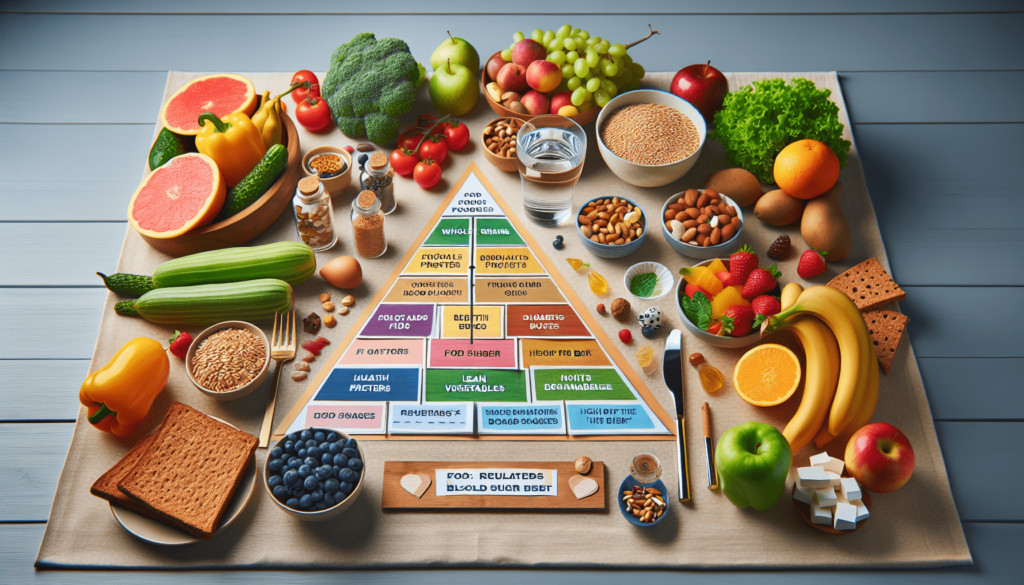Managing diabetes can often feel like a complicated juggling act, where you have to carefully balance your blood sugar levels while still enjoying the foods you love. It can be a challenging task, but with the right approach, it’s entirely possible to find a healthy and delicious diet that supports your diabetes management goals. In this article, we will explore the importance of balancing diabetes management and enjoyment through a healthy diet, providing helpful tips and strategies specifically tailored to women who face the unique challenges of living with diabetes. So get ready to embark on a journey of discovering a nourishing and satisfying way of eating that will empower you to take control of your diabetes while still relishing in the joys of food.
In This Article
ToggleUnderstanding Diabetes Management
Living with diabetes requires a thoughtful and comprehensive approach to managing your health. Diabetes occurs when the body’s ability to regulate blood sugar levels becomes impaired. This can lead to serious health complications if not properly managed.
What is diabetes?
Diabetes is a chronic condition that affects the way your body processes glucose, which is the main source of energy for your cells. The pancreas, a gland located behind the stomach, produces insulin, a hormone that helps regulate blood sugar levels. In people with diabetes, either the pancreas does not produce enough insulin or the body cannot effectively use the insulin it produces. This leads to elevated blood sugar levels, which can have harmful effects on various organs and systems in the body.
Types of diabetes
There are several types of diabetes, but the most common ones are type 1 diabetes, type 2 diabetes, and gestational diabetes.
-
Type 1 diabetes: This type is usually diagnosed in childhood or early adulthood and occurs when the immune system mistakenly attacks and destroys the insulin-producing cells in the pancreas. People with type 1 diabetes need to take insulin injections or use an insulin pump to regulate their blood sugar levels.
-
Type 2 diabetes: This type is the most common form of diabetes and is often diagnosed in adulthood. Type 2 diabetes occurs when the body becomes resistant to insulin or does not produce enough insulin to adequately regulate blood sugar levels. Lifestyle factors such as unhealthy diet, lack of physical activity, and obesity can contribute to the development of type 2 diabetes.
-
Gestational diabetes: This type of diabetes occurs during pregnancy and usually resolves after giving birth. However, it is important to manage gestational diabetes to prevent complications for both the mother and the baby.
Importance of diabetes management
Managing diabetes is crucial to prevent or delay complications associated with the condition. When blood sugar levels are not well-controlled, it can lead to long-term damage to the heart, blood vessels, kidneys, eyes, and nerves. By actively managing diabetes, you can reduce the risk of these complications and maintain a higher quality of life. Proper diabetes management includes a combination of healthy lifestyle choices, medication (if necessary), and regular monitoring of blood sugar levels.
Components of a Healthy Diet
A healthy, balanced diet is foundational to managing diabetes effectively. By making thoughtful food choices, you can help control your blood sugar levels and promote overall health and wellbeing. Here are the key components of a healthy diet for diabetes management:
Carbohydrates
Carbohydrates play a significant role in blood sugar control as they are broken down into glucose during digestion. It is important to differentiate between different types of carbohydrates and understand their impact on blood sugar levels.
Proteins
Proteins are essential for building and repairing tissues in the body. They have a minimal impact on blood sugar levels and can help you feel full and satisfied after a meal.
Fats
While fats have a reputation for being unhealthy, certain types of fats are actually beneficial for overall health. Healthy fats, such as those found in nuts, avocados, and fatty fish, can be part of a balanced diet.
Fiber
Fiber is a type of carbohydrate that cannot be fully digested by the body. It helps regulate blood sugar levels, promotes digestive health, and can contribute to weight management.
Vitamins and minerals
Vitamins and minerals are essential for various bodily functions and can have a significant impact on overall health. Ensuring you consume an adequate amount of these nutrients is crucial for managing diabetes effectively.

This image is property of images.pexels.com.
Managing Carbohydrate Intake
Carbohydrates have the most significant impact on blood sugar levels, so managing their intake is critical for diabetes management. Here are some strategies to help you effectively manage your carbohydrate consumption:
Counting carbohydrates
A popular method for managing carbohydrates is carbohydrate counting. This involves determining the number of grams of carbohydrate in a food item and then adjusting insulin doses or mealtime medications accordingly.
Choosing complex carbohydrates
Complex carbohydrates are digested more slowly by the body, resulting in a gradual release of glucose into the bloodstream. This helps prevent sudden spikes in blood sugar levels. Examples of complex carbohydrates include whole grains, legumes, and vegetables.
Limiting simple sugars
Simple sugars, also known as refined sugars, are found in many processed foods and beverages. These sugars are quickly absorbed by the body, leading to rapid increases in blood sugar levels. It is important to limit your consumption of sugary foods and drinks.
Balancing carbohydrates with proteins and fats
Pairing carbohydrates with proteins and fats can help slow down the absorption of glucose into the bloodstream. This promotes more stable blood sugar levels and can help you feel full and satisfied for longer periods.
Making Smart Protein Choices
Protein is an essential nutrient and plays an important role in diabetes management. When choosing protein sources, it is crucial to opt for lean options and consider different alternatives, especially if you follow a plant-based diet. Here are some strategies for making smart protein choices:
Lean protein sources
Choose lean sources of protein such as skinless poultry, fish, tofu, and legumes. These options are lower in unhealthy fats and can help maintain healthy blood sugar levels.
Plant-based proteins
If you follow a vegetarian or vegan diet, incorporating plant-based protein sources like lentils, chickpeas, quinoa, and tofu can provide the necessary protein while being low in saturated fats.
Monitoring portion sizes
Regardless of the type of protein you choose, it is important to moderate your portion sizes. Protein foods still contain calories, and consuming excessive amounts can contribute to weight gain, which can affect blood sugar control.

This image is property of images.pexels.com.
Understanding the Role of Fats
Fats are an essential part of a healthy diet and play a crucial role in diabetes management. However, not all fats are created equal, and understanding the difference can help you make smarter choices. Here’s what you need to know:
Healthy fats
Healthy fats, such as monounsaturated and polyunsaturated fats, can have a positive impact on heart health and blood sugar control. Sources of healthy fats include avocados, nuts, seeds, and fatty fish like salmon.
Limiting saturated and trans fats
Saturated fats and trans fats have been linked to an increased risk of heart disease and can negatively affect insulin sensitivity. It is important to limit your consumption of foods high in saturated fats, such as fatty meats, full-fat dairy products, and fried foods. Trans fats, often found in processed and packaged foods, should also be avoided as much as possible.
Reading food labels for fat content
When grocery shopping, take the time to read food labels and pay attention to the fat content. Aim for foods that are low in saturated and trans fats, and opt for healthier fat sources instead.
Increasing Fiber Intake
Fiber is an important component of a diabetes-friendly diet. It aids in blood sugar control, promotes digestive health, and can assist with weight management. Here’s how you can increase your fiber intake:
Benefits of fiber for diabetes management
Fiber slows down the absorption of glucose into the bloodstream, which helps regulate blood sugar levels. It also promotes feelings of fullness and can contribute to better weight management.
Sources of dietary fiber
Include plenty of fruits, vegetables, whole grains, legumes, and nuts in your diet. These foods are rich in dietary fiber and can help you meet your daily fiber needs.
Tips for increasing fiber in your diet
Gradually increase your fiber intake to avoid digestive discomfort. Start by adding small amounts of fiber-rich foods to your meals and gradually increase the portions. Make sure to drink plenty of water to help with digestion.

This image is property of images.pexels.com.
Incorporating Vitamins and Minerals
Vitamins and minerals are essential nutrients that play a vital role in overall health and diabetes management. Here’s what you need to know about incorporating them into your diet:
Importance of essential nutrients
Vitamins and minerals are involved in various bodily functions, including metabolism, immune system health, and nerve function. Ensuring you consume an adequate amount of these nutrients is crucial for managing diabetes effectively.
Diabetes-friendly sources of vitamins and minerals
Focus on consuming a variety of whole, nutrient-dense foods to obtain essential vitamins and minerals. Incorporate plenty of fruits, vegetables, lean proteins, whole grains, and low-fat dairy products into your diet.
Supplements for diabetes management
While it’s ideal to obtain essential nutrients from whole foods, some individuals may benefit from supplements, especially if they have specific nutrient deficiencies. Consult with a healthcare professional before starting any supplements to ensure they are appropriate for your individual needs.
Creating a Balanced Meal Plan
Meal planning is an essential tool for successful diabetes management. By following a balanced meal plan, you can ensure you’re getting the right nutrients while keeping your blood sugar levels in check. Here’s how to create a balanced meal plan:
Meal planning basics
Plan your meals in advance to have a clear idea of what you’ll be eating throughout the week. Incorporate a variety of foods from all food groups to ensure a balanced intake of essential nutrients.
Portion control
Pay attention to portion sizes to maintain a healthy weight and keep your blood sugar levels stable. Use measuring cups or a food scale to accurately portion your meals and avoid overeating.
Balancing macronutrients
Include a combination of carbohydrates, proteins, and fats in each meal to help maintain steady blood sugar levels and keep you satisfied. Consider consulting a registered dietitian to help you tailor a meal plan to your specific needs.
Snack options for diabetes management
Choose nutritious snacks that are low in added sugars and high in fiber and protein. Examples include a handful of nuts, a piece of fruit with nut butter, or Greek yogurt with berries.

Practical Tips for Enjoying Food with Diabetes
Having diabetes doesn’t mean you have to give up your favorite foods or sacrifice enjoyment. By making mindful choices and incorporating healthy substitutes, you can continue to savor delicious meals while managing your diabetes effectively. Here are some practical tips:
Enjoying favorite foods in moderation
It’s okay to enjoy your favorite foods occasionally, as long as you do so in moderation and consider their impact on your blood sugar levels. Plan for these indulgences in your overall meal plan and adjust your portion sizes and carbohydrate intake accordingly.
Finding healthy substitutes
Discover healthier alternatives to your favorite foods that are lower in sugar, unhealthy fats, or carbohydrates. For example, replace white rice with cauliflower rice or opt for whole-grain bread instead of white bread.
Exploring new recipes and flavors
Expand your culinary repertoire by exploring new recipes that are both delicious and diabetes-friendly. There are countless resources available, including cookbooks and online recipe collections, to help you find creative and tasty options.
Mindful eating practices
Practice mindful eating by slowing down, savoring each bite, and paying attention to your body’s hunger and fullness cues. This can help prevent overeating and promote a healthier relationship with food.
Seeking Professional Guidance
Managing diabetes can be challenging, and seeking professional guidance can provide valuable support and assistance. Here are a few avenues to consider:
Consulting a registered dietitian
Registered dietitians are experts in nutrition and can provide personalized recommendations based on your individual needs. They can help you create a meal plan, navigate food choices, and answer any questions you may have.
Working with a diabetes educator
Diabetes educators specialize in diabetes management and can provide education, support, and guidance. They can help you understand the best practices for managing your diabetes and assist you in making lifestyle changes.
Regular check-ups and adjustments
Regularly visit your healthcare provider for check-ups and blood sugar monitoring. They can help you make any necessary adjustments to your treatment plan and provide ongoing support as you manage your diabetes.
By understanding the components of a healthy diet, knowing how to manage carbohydrate intake, making smart choices for proteins and fats, increasing fiber intake, and incorporating vitamins and minerals, you can create a balanced meal plan and enjoy food while effectively managing diabetes. Remember to seek professional guidance and make mindful choices to ensure your diabetes management aligns with your overall health goals.
Related posts:
 Long-Term Health Concerns for Women with Diabetes
Long-Term Health Concerns for Women with Diabetes
 What are the best sources of protein for a healthy diet?
What are the best sources of protein for a healthy diet?
 Puravive Review Revealed: How This New Supplement Is Changing the Game in Healthy Weight Management
Puravive Review Revealed: How This New Supplement Is Changing the Game in Healthy Weight Management
 What are healthy fats and how can they benefit my diet?
What are healthy fats and how can they benefit my diet?
 Maintain a Healthy Metabolism with Culturelle Healthy Metabolism Supplement, 30 Capsules
Maintain a Healthy Metabolism with Culturelle Healthy Metabolism Supplement, 30 Capsules
 Estroven Weight Management: A Natural Solution for Menopause Symptoms and Weight Control – 30 Caplets
Estroven Weight Management: A Natural Solution for Menopause Symptoms and Weight Control – 30 Caplets










No comment yet, add your voice below!